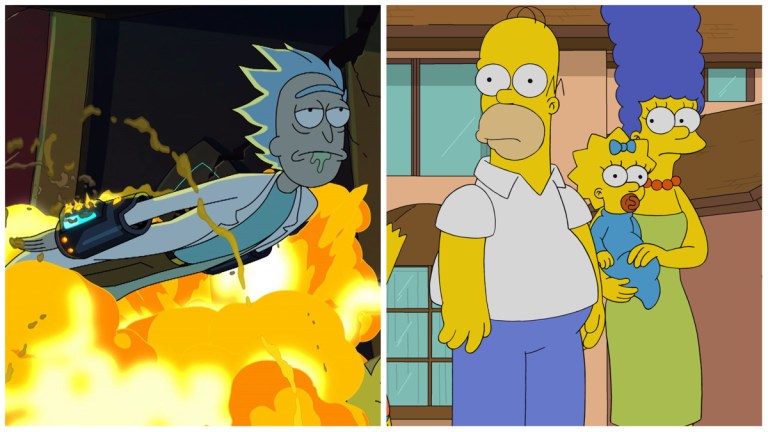What Rick and Morty Can Learn From The Simpsons
If Rick and Morty wants to run for a thousand episodes, it will have to pick up some lessons from another animated classic.

In 2018, Adult Swim ordered another 70 episodes of Rick and Morty to air over multiple seasons. While some of those episodes have now been released, it was a wider indication that not only was the studio happy with the show, but that they saw it had long-term potential. Creators Justin Roiland and Dan Harmon feel exactly the same way. In a recent interview with The Wrap Roiland said “I think the show could run forever.”
But they also addressed a comparison that had been made in conjunction with the renewal news. Justin Roiland went on to say “We’re also not trying to do what The Simpsons is doing and we’re doing less episodes than The Simpsons.” Yet, when looking to shows that have enjoyed incredible longevity, the 20th Century Studios series is definitely one to learn lessons from. Rick and Morty is already seemingly following some of the formula of The Simpsons despite what its creators are saying, but how else can the Adult Swim show look to its Disney/Fox competitors in ensuring it remains relevant for the foreseeable future?
Mixing Continuity
Continuity has always been a major point of discussion for Rick and Morty as it flirts between allowing most of its seasons to feel very standalone, before a sudden and unexpected arc calls back to a previous adventure or villain. That’s been the case with the likes of Birdperson or Evil Morty, but the first episode of the latest season of the show seemingly promised more continuity focused storylines moving forward.
The Simpsons has also had to manage this balance between throwing back to past stories and ensuring that each episode felt fresh and self-contained for any new viewers who might jump in. The Fox show saw great success in rewarding both long-term fans and remaining consistently accessible for anyone jumping in for the first time. Rick and Morty should carry on its current trajectory if it is to reach the scale and longevity of The Simpsons. After all, the longer the show goes on, the more damaging it would be to its success if fans had to watch from the very beginning. Season lengths do make a big difference though, with the shorter seasons of Rick and Morty definitely making continuity easier to track than the often 20+ episode run of The Simpsons
Bringing In Guest Stars
Longevity can sometimes be based on ratings and those can be impacted by any number of components. The Simpsons mastered a simple technique to continue to boost their viewing figures, by stealing a trick that is firmly cemented in sitcom history. The guest star spot has seen huge names making their way to Springfield, with the likes of Michelle Pfeiffer, Johnny Cash, Meryl Streep, Ed Sheeran, James Earl Jones, and even recently Billie Eilish, lending their vocal talents to the show.
Of course, while the list goes on and on for The Simpsons, Rick and Morty is beginning to follow a similar approach, with some acting legends of the past and present also getting the opportunity to contribute to the sci-fi series. Taika Waititi, Patton Oswalt, Sam Neill, Susan Sarandon, Jeffrey Wright, Danny Trejo, and Kathleen Turner are just a few examples from the adventures of the Smith family. Rick and Morty would be wise to continue to use this gimmick to build interest in the series, as viewers tune back in to see how some of their favourite performers might fit into this whimsical universe.
Building Out An Ensemble
For there to be guest stars, there also has to be a wider range of characters for them to inhabit, that believably contribute to the narrative. That’s easier to achieve when an ensemble has been established. The Simpsons might focus on the titular family that viewers regularly find sitting on the couch, but the list of supporting parts in Springfield is almost endless. So many different figures have allowed for such a diverse range of narratives, that pull from multiple points of view. The sitcom can return to any of these faces at any point, allowing for the core cast of characters to still feel fresh. Everyone has a favourite outside of Marge, Homer, Lisa, Bart and Maggie, whether it’s Flanders, Krusty, Patty or Selma!
Rick and Morty hasn’t fully established itself as an ensemble quite in the same way as The Simpsons. It has returned to a few recurring characters like Birdperson, Tammy and Mr. Poopybutthole, but for the large part the figures that audiences are introduced to don’t last much longer than an episode. The show got great narrative longevity out of the President (Keith David) for instance and that can be achieved on a grander scale with a larger roster of characters to pull from. Rick and Morty can continue to go on their intergalactic adventures with fresh faces each time, but it wouldn’t hurt to have a few return here and there, not just for continuity sake, but to widen the depth of stories to tell. That’s partially how The Simpsons has kept reimagining new escapades for so long.
Regular Event Episodes
The Simpsons hasn’t heavily relied upon event episodes in its run, but it has established a few conventions that gives fans something to look forward to. It’s tradition for instance to air a Treehouse of Horror episode for Halloween, with Disney+ day also starting a new trend of themed shorts each year on the streaming service. It’s a fun precedent to set, with the continuity of the show getting completely broken in favor of some kind of event-based celebration.
Rick and Morty recently moved into similar territory, making a point of exaggerating another Thanksgiving episode. Of course, it didn’t even air during the right time of year, but that only adds to the ridiculous spectacle of the event. Rick and Morty could make these Thanksgiving episodes annual releases, similar to how Treehouse of Horror has set itself as a mainstay of the spooky season. Years down the line, the science fiction show will have formed a new tradition, that only adds to its long-term appeal.
Keeping The Status Quo
Continuity isn’t quite the same as the status quo. Sideshow Bob’s continued obsession with killing Bart is all part of the canon of the show, but at the end of each episode the status quo has still remained the same. The Simpsons has made a habit of never changing. The characters never age, never truly evolve and Springfield pretty much reboots every time the intro music plays. There are a few exceptions to that rule, including the death of Maude Flanders, which makes those moments even more impactful.
Rick and Morty is settling into a status quo of its own. With the portal gun and car destroyed, many of the family’s adventures take place from the house, much like The Simpsons. Any character development seems to have been halted for the most part, with each member of the Smith household falling into line with their main personality traits. Morty for instance underwent the most metamorphosis, but with his doubt in Rick being wiped, could it be that this is the reality from now on? In fact, the show makes a joke of the status quo, with the characters acknowledging they never seem to age, and Rick jumping through whole universes to find an Earth that is exactly the same. Perhaps that’s all part of a larger plan to establish a firm rhythm to sometimes play around with, thus contributing to the longevity of the series once more.
Intro Gags
The intro to any series sets the tone of the show. The Simpsons theme music is absolutely iconic, and each episode is launched with a couch gag, involving the titular family and their famous sofa. Rick and Morty themselves have even appeared during one such intro, with a small joke always kicking off proceedings in an unexpected way.
The theme music for Rick & Morty is beginning to take hold after six seasons. The clips used in the intro have also changed per series, but the idea that some of them might not even appear in the show has opened the door for further red herrings, or perhaps physical jokes made purely for the title sequence. Just like Hulu’s Solar Opposites plays around with how it introduces audiences to an episode, forcing viewers to not skip past those credits, Rick & Morty can do the same, establishing its own shifting pattern of jokes to make the intro as unmissable as The Simpsons.
The Benefit Of Meta Relevancy
The Simpsons has strangely always managed to remain culturally relevant, often through odd predictions of the future. The sitcom has both reflected the world outside and even pre-empted it, shocking fans years later with its surprising accuracy. There is a layer of meta commentary to the show, with each series really reflecting the mood of the period it was made in. In some ways, The Simpsons could be considered an important cultural time capsule.
Rick and Morty has a long way to go before it can leave a legacy like this predecessor. But it hasn’t shied away from the notion that it can produce meta jokes and comment on the real-world directly. It’s an idea that will in its nature continue to allow the show to remain relevant, as the writers will always have the opportunity to muse on something new, unburdened even by any fourth wall. That’s a real gift for anyone who wants the voice of the show to evolve.
The Simpsons really is the blueprint, not only for beloved animated shows, but long-running sitcoms in general. As of this writing, 729 episodes of The Simpsons have aired. Rick and Morty has a long way to go before it could remotely hit those numbers. But Dan Harmon was optimistic of the series’ chances, saying “I think a good TV show is one that lasts 1000 episodes.” If the Adult Swim outing was to reach those dizzying heights, then following the floor plans set out by The Simpsons, as it is evidently doing despite claims from its creators, is the best way forward.
